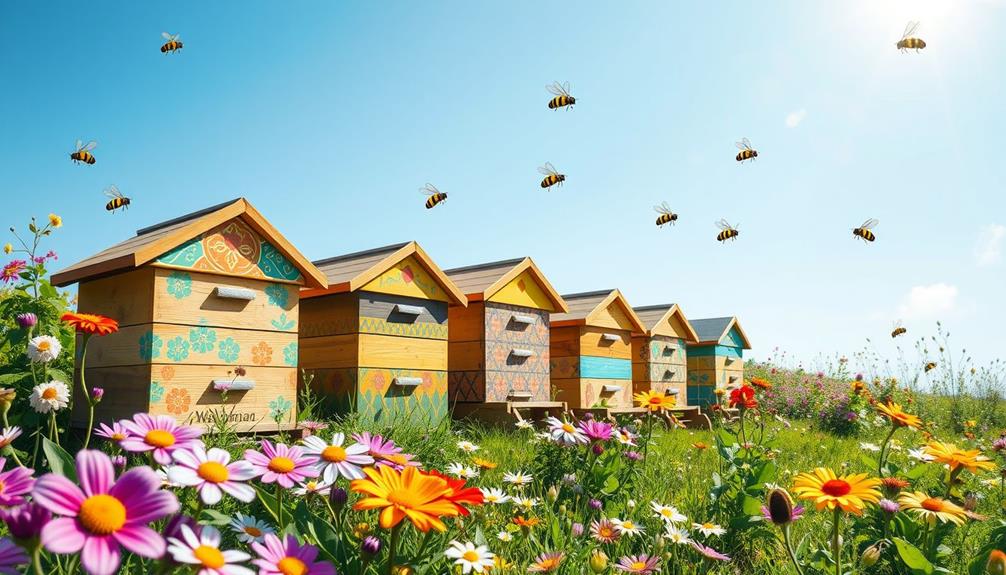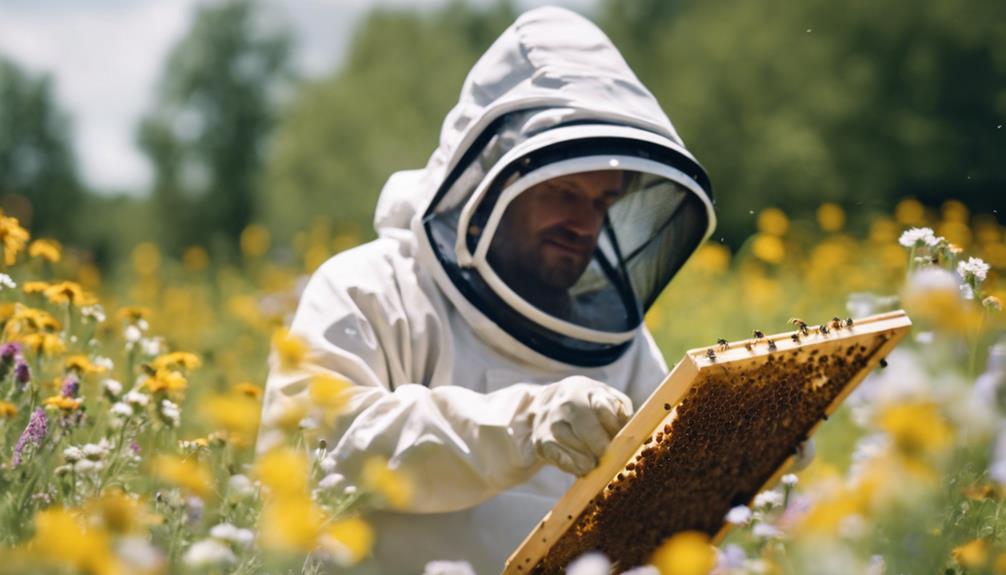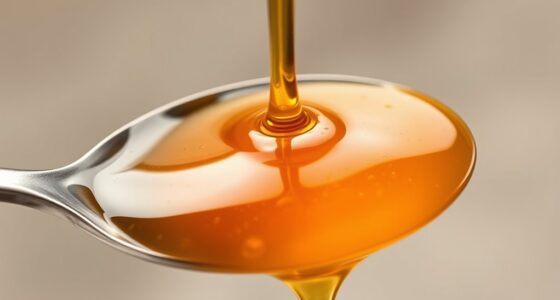Queen bees play an essential role in colony dynamics, driving reproductive processes and maintaining social order within the hive. They lay up to 2,000 eggs daily, which sustains the colony's population and health. Their pheromones regulate worker bee behavior, suppressing reproduction and promoting hive productivity. When a queen is absent, workers respond swiftly, initiating the queen rearing process to guarantee stability. Additionally, marking queens helps beekeepers track their health and lineage. Understanding these aspects can deepen your insight into bee behaviors and management strategies, inviting you to explore more about these fascinating creatures and their vital roles.
Key Takeaways
- The queen bee's pheromonal communication regulates worker reproduction and behavior, maintaining the colony's social structure and productivity.
- She initiates egg laying in late February, producing up to 2,000 eggs daily, vital for colony population growth and health.
- Successful mating of young queens ensures genetic diversity, crucial for colony resilience and long-term survival.
- Worker bees rapidly respond to reduced pheromone signals by selecting larvae to raise new queens, showcasing their adaptability.
- Marking queens helps beekeepers track health and age, improving management of colony dynamics and productivity.
Queen Bee Development

In a honeybee colony, the development of a queen bee is a captivating process that sets her apart from worker bees. It all starts with fertilized eggs chosen by worker bees, who feed these selected eggs exclusively royal jelly. This special diet triggers their transformation into queens, rather than the typical worker bee development. The entire process takes about 16 days, with pupation lasting around 8 days before the new queen emerges.
This unique transformation underscores the significance of fascinating facts about stingless bees, showcasing how different species adapt their reproductive strategies.
Once she hatches, the young queen has an essential task ahead of her. Within 1-2 weeks, she'll set out on nuptial flights, mating with up to 12 drones. This mating guarantees genetic diversity, crucial for the colony's health.
After her mating flights, the queen's primary role begins—egg-laying. During peak season, she can lay up to 2,000 eggs a day, greatly boosting the colony's population. This prolific egg-laying is fundamental for maintaining the hive's dynamics.
If a queen's pheromones are absent, worker bees recognize the need for a new queen and will initiate queen rearing, converting selected brood cells into queen cells. This remarkable process highlights the queen's central role in colony dynamics.
Egg Laying and Colony Health
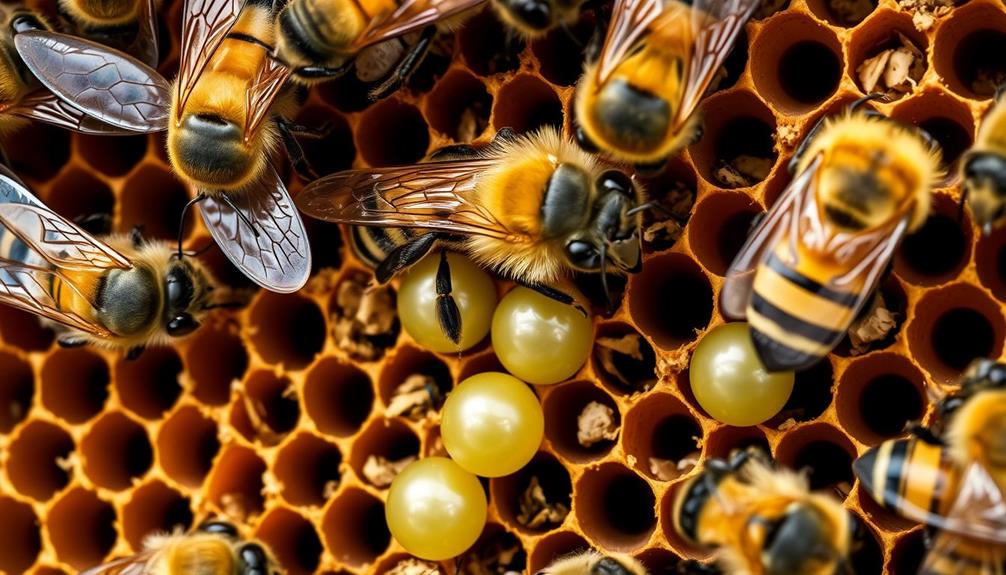
Egg laying is the heartbeat of a honeybee colony, directly influencing its health and energy. As the queen begins laying eggs in late February, when temperatures consistently reach 10°C, she can produce up to 2,000 eggs daily, surpassing her body weight. This prolific egg production is essential for maintaining the colony's population and overall health.
Mastering the Art of Bug Out Bags emphasizes the importance of preparedness, which can also relate to the meticulous organization seen in a well-functioning bee colony. If the queen is lost outside of the brood period, the colony faces severe survival risks.
In her absence, worker bees can lay eggs, but these only turn into drones, which can lead to an imbalance in the colony's structure. A young queen may struggle to mate successfully, resulting in an increased drone population that doesn't contribute to the hive's productivity.
Throughout the year, the colony's strength fluctuates, peaking around the summer solstice. Stronger bee races, like the Buckfast bee, can reach populations of up to 50,000 individuals.
A healthy queen is critical for the hive's productivity, as her presence stimulates worker bees to gather nectar and maintain colony activity. Therefore, the queen's egg-laying capacity directly correlates with the vitality of the entire hive, making her role indispensable.
Pheromonal Communication

Pheromonal communication among honeybees serves as the backbone of their social structure, guaranteeing cohesion and proper functioning within the colony. The queen releases a pheromone known as the queen substance, which suppresses the reproductive capabilities of the worker bees. This suppression helps maintain order and focus, allowing the colony to thrive.
In addition to this primary role, these pheromones can influence foraging behavior and hive maintenance, creating a well-organized environment that supports colony health. When the pheromone's presence diminishes, it signals the death or loss of the queen, prompting the workers to initiate queen rearing. They transform specific brood cells into queen cells, guaranteeing the colony's survival.
Pheromones play a significant role in regulating behaviors and reproductive functions. The intensity of the pheromone release directly influences the workers' actions; higher concentrations exert stronger control over their reproductive abilities. Consequently, the queen's ability to produce pheromones is essential for maintaining the colony's social structure and organization.
Queen Replacement Processes

When a queen bee is absent, you'll notice the worker bees spring into action, sensing the lack of her pheromone signals.
This quick response is essential for the colony's survival and mirrors concepts like accountability in financial planning, where timely decisions can greatly impact overall health.
They quickly decide to rear a new queen by selecting the right larvae and preparing special queen cells.
Understanding this process is key to grasping how a colony maintains its strength and productivity.
Pheromone Signals for Replacement
The intricate dynamics of a bee colony hinge on the queen's pheromonal signals, which play an important role in maintaining order and facilitating replacement processes. The queen releases a pheromone known as "queen substance" through her mandibles. This pheromone suppresses the reproductive capabilities of the worker bees and guarantees cohesion within the colony.
When the concentration of this pheromone drops below a specific threshold, the worker bees recognize the queen's absence and initiate the process of raising new queens. To do this, the workers transform certain brood cells into queen cells. This behavior is an evolutionary adaptation, allowing sterile worker bees to pass on genetic material and thereby enhance the colony's survival.
Typically, it takes about 16 days for the larvae to develop into queen cells after the workers start the breeding process, showcasing the colony's rapid response to the loss of a queen. The successful mating of the new queen during her nuptial flight is vital for the colony's genetic diversity. By mating with multiple drones, she increases the genetic adaptability of the colony, which is important for thriving in changing environments.
Worker Bee Decision-Making
In the bustling hive, worker bees quickly assess their environment and respond decisively to changes in the queen's pheromone levels. When the concentration drops below a critical threshold, it signals a need for a new queen, prompting workers to initiate the replacement process. This decision-making is essential for hive survival.
| Trigger for Replacement | Action by Worker Bees |
|---|---|
| Queen's death | Begin queen replacement process |
| Decline in queen's productivity | Select larvae for new queen development |
| Swarming events | Convert brood cells into queen cells |
| Low pheromone levels | Feed selected larvae royal jelly |
To raise a new queen, workers choose several larvae and transform brood cells into queen cells. They feed the selected larvae a rich diet of royal jelly, which is critical for queen development. Once a new queen emerges, she typically engages in nuptial flights, mating with multiple drones to guarantee genetic diversity. The successful establishment of a new queen is essential for the colony's health, directly affecting productivity and cohesion within the hive.
Queen Cell Development Process
Queen cell development is an essential process in colony dynamics, guaranteeing the hive's survival when the queen is lost or aging. When this happens, worker bees spring into action, selecting several young larvae, typically less than three days old. They convert regular brood cells into queen cells by feeding these larvae exclusively with royal jelly, which triggers their transformation into queens.
The entire process spans around 16 days. During this time, the larvae develop into queens, emerging as larger bees with elongated abdomens.
Once the new queen emerges, she'll take to the skies for nuptial flights, mating with multiple drones to ascertain genetic diversity within the colony. This step is fundamental for maintaining a healthy and resilient hive.
However, if she's unable to mate successfully, she may resort to laying unfertilized eggs. This can lead to an increased drone population, which poses a significant risk to the colony's long-term viability.
Consequently, the queen cell development process not only replaces the queen but also plays an important role in sustaining the overall health and stability of the bee colony.
Marking Practices and Significance

Marking practices for queens in a beehive serve both practical and significant purposes. Beekeepers use colored opalith plates or marking pens, with specific colors changing annually and repeating every five years.
You'll start with white for the year of the queen's birth, providing a clear visual cue.
The marking process involves temporarily removing the queen from the hive, securing her in a holder, and applying non-toxic adhesive to the marking plate. This method guarantees easy identification.
Resources for Further Reading
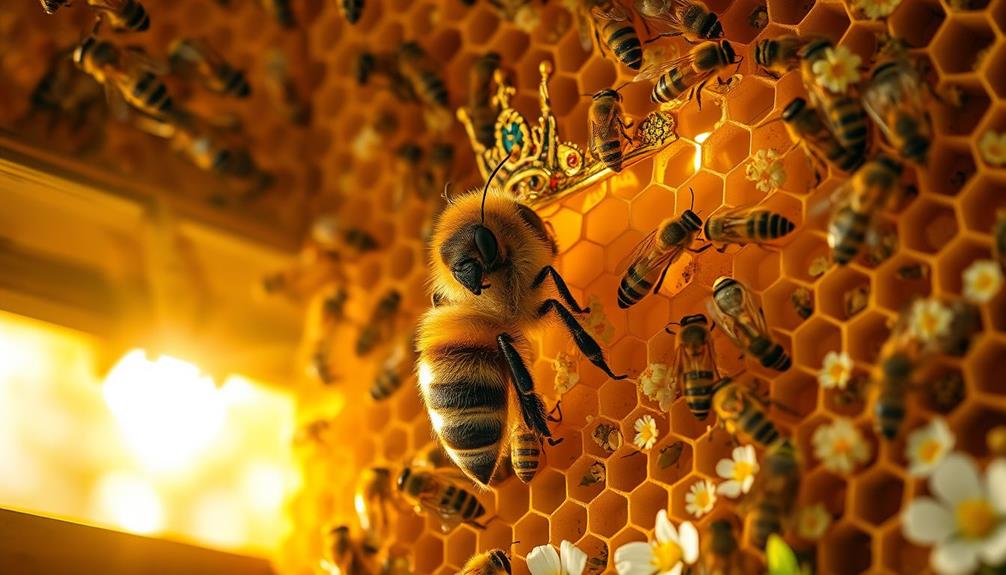
If you're looking to expand your knowledge about queen bees and their role in colony dynamics, there are several excellent resources available.
Recommended literature like "Königinnenzucht" and "Neue Imkerschule" offers practical insights into beekeeping techniques and queen management.
Additionally, online platforms and historical archives provide valuable context, enriching your understanding of beekeeping practices throughout the ages.
Recommended Literature on Beekeeping
When diving into the world of beekeeping, having the right literature at your fingertips can make all the difference. A must-read is "Königinnenzucht" by Fert Gilles and Klaus Nowottnick, which offers extensive insights into queen breeding practices and genetic management of bee colonies. This book will deepen your understanding of how to maintain a healthy hive through effective queen management.
Another valuable resource is "Neue Imkerschule" by Edmund Herold and Karl Weiß. This book covers modern beekeeping techniques, focusing on the importance of queen health for hive productivity. You'll find practical tips to enhance your beekeeping practices.
To further aid your learning, consider utilizing Wiktionary as a tool for grasping the terminology related to bee queens and their roles in the hive. Understanding this language can greatly enhance your comprehension of beekeeping literature.
Lastly, don't overlook visual resources available on Commons. These images and videos illustrate queen bee dynamics and management practices, complementing the textual information you'll encounter.
Online Resources and Archives
A wealth of online resources and archives awaits you as you explore the fascinating world of queen bees and colony dynamics. Start with Wiktionary, where you'll find definitions and etymological insights into the term "bee queen." Understanding its linguistic roots can enhance your grasp of the subject.
Then, check out Wikimedia Commons, which offers a rich collection of images, videos, and audio files related to bee queens. These visual and auditory resources can make your learning experience more engaging and help you visualize concepts more clearly.
For in-depth literature, consider "Königinnenzucht" by Fert Gilles & Klaus Nowottnick. This book investigates queen breeding practices that are essential for modern beekeeping.
Another significant resource is "Neue Imkerschule" by Edmund Herold & Karl Weiß, which supports your understanding of queen roles and colony management within apiculture.
While you might come across historical archives documenting beekeeping practices, remember to focus on resources that enhance your current understanding of queen bees.
These online tools will provide a well-rounded perspective on their important role in colony dynamics.
Historical Beekeeping Practices
Exploring historical beekeeping practices reveals how deeply intertwined humans have been with bees throughout civilization. Evidence of honey harvesting dates back to ancient Egypt, where you can find depictions in tombs and frescoes from the Minoan civilization around 2000 BCE.
Beekeeping in classical Greece saw scholars like Aristotle document bee behavior and biology, laying the foundation for modern apiculture and our understanding of bee colony dynamics.
The 19th century brought a revolution with Lorenzo Langstroth's introduction of movable-frame hives, making honey extraction and colony management more efficient. These innovations transformed how you interact with bees and manage their colonies.
Traditional queen-rearing methods, such as grafting and using queen cells, have been practiced for centuries. You'll find modern literature supporting these techniques, emphasizing their role in enhancing genetic diversity and promoting colony health.
Additionally, the cultural significance of beekeeping is evident in various folklore, where bees and honey symbolize prosperity and community.
Artists and thinkers like Joseph Beuys have incorporated these themes into their work, highlighting the enduring relationship between humans and bees. Understanding these historical practices enriches your appreciation for beekeeping today.
Frequently Asked Questions
What Tasks Do Queen Bees Have?
Queen bees lay thousands of eggs daily, regulating colony growth. They produce pheromones to manage worker behavior and maintain cohesion. Their mating flights guarantee genetic diversity, directly affecting the colony's productivity and health.
What Role Does the Queen Bee Play in the Beehive?
Did you know a queen bee can lay up to 2,000 eggs daily? In the beehive, she's essential, regulating reproduction and maintaining harmony, ensuring the colony thrives and adapts through her unique genetic contributions.
What Does the Queen Bee Do When the Colony Becomes Too Large?
When the colony gets too large, you'll notice the queen initiates swarming. She leaves with some worker bees, ensuring a new colony forms while the remaining workers raise a new queen from the existing brood.
Why Is the Queen Bee Important?
Imagine the heart of a bustling city; that's the queen bee for her colony. She's essential for health, laying thousands of eggs daily, regulating behavior, and ensuring stability, making her the cornerstone of hive life.
Conclusion
In conclusion, understanding queen bees is essential for appreciating colony dynamics. You might think their role is just about reproduction, but it's so much more! Their pheromonal signals influence the entire hive, ensuring harmony and productivity. Plus, knowing about queen replacement and marking practices gives you a deeper insight into beekeeping. So, whether you're a hobbyist or a professional, recognizing the multifaceted role of queen bees can enhance your experience and success in maintaining healthy colonies.

